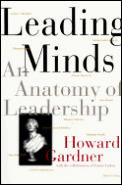 Howard Gardner’s Leading Minds: An Anatomy of Leadership is extraordinarily ambitious. It attempts to do nothing less than create a cognitive framework for all that has been learned about leadership. Like Gardner’s earlier Frames of Mind (1983), The Mind’s New Science (1986), and Creating Minds (1993), this book is the product of his research into creativity and influence, undertaken at Harvard University’s Graduate School of Education.
Howard Gardner’s Leading Minds: An Anatomy of Leadership is extraordinarily ambitious. It attempts to do nothing less than create a cognitive framework for all that has been learned about leadership. Like Gardner’s earlier Frames of Mind (1983), The Mind’s New Science (1986), and Creating Minds (1993), this book is the product of his research into creativity and influence, undertaken at Harvard University’s Graduate School of Education.
Gardner fleshes out his theoretical notions in lively minibiographies of eleven twentieth-century leaders, beginning with Margaret Mead and ending with Mahatma Gandhi. The brief biographies are a delight and an education, full of useful hints and signposts, if not answers.
One of Gardner’s central ideas is that effective leaders—the Hitlers as well as the Roosevelts—tell or embody stories that speak to other people. By leaders, Gardner does not mean only CEOs or heads of state. In his view, leaders are all those “persons who by word and/or personal example, markedly influence the behaviors, thoughts and/or feelings of a significant number of their fellow human beings.”
Gardner also charts leadership in terms of its widening impact: from influence exercised within relatively narrow domains, such as academic specialties, to influence exercised over larger communities, such as the influence Pope John XXIII exerted over the Roman Catholic Church. In addition, he describes a hierarchy of leadership based on creativity, with smaller-scale leaders such as educator Robert Maynard Hutchins at the bottom and visionaries such as Gandhi at the top.
The four factors Gardner lists as essential for effective leadership are a tie to a community or audience; a rhythm of life that includes isolation and immersion; a relationship between the stories leaders tell and the traits they embody; and arrival at power through the choice of the people rather than through brute force.
The magic of the book is this juxtaposition of the theoretical with the telling particulars. It is useful to learn that J. Robert Oppenheimer, head of the Manhattan Project and later a controversial spokesman for the responsible use of nuclear energy, began as an indirect leader within the relatively limited universe of theoretical physics. More interesting, however, is the idiosyncratic nature of Oppenheimer’s leadership, vividly revealed in Gardner’s account of Oppenheimer’s career.
Gardner knows that the right anecdote can be worth a thousand theories. For example, rather than write at length on how Oppenheimer’s leadership sometimes failed because of his arrogance, Gardner gives a single example: Oppenheimer’s icy dismissal of Washington Post publisher Philip Graham for having failed to read some text in the original Sanskrit. In the same chapter, Gardner provides a glimpse of moral leadership when he recounts how President Lyndon Johnson (not one of Gardner’s eleven) ended Oppenheimer’s unofficial banishment from public life by presenting him with the Enrico Fermi Award. Oppenheimer showed his profound understanding of the significance of Johnson’s action when he said, “I think it is just possible, Mr. President, that it has taken some charity and some courage for you to make this award today. That would seem to me a good augury for all of our futures.”
In the patterns of leadership that Gardner traces, several elements recur that have not been emphasized enough in earlier work on the subject. Travel, for instance, was even more important than formal education in shaping many of Gardner’s leaders, including John XXIII and Gandhi. Gardner points out that nonauthoritarian leaders are more likely than authoritarian leaders to have traveled extensively abroad. Many leaders went on almost mythic interior journeys involving testing and rebirth. Gardner shows how Eleanor Roosevelt, who had to deal with both her husband’s polio and his love for another woman, responded by reinventing herself as an increasingly independent advocate for the causes that were most important to her, notably women’s rights and civil rights.
Uncommon eloquence marks virtually every one of Gardner’s leaders, but I have yet to see public speaking listed on a résumé. We seem to regard the ability to galvanize an audience as something almost tawdry, even dangerous. Yet it was the eloquence of Martin Luther King, Jr., grounded in the cadences of thousands of his father’s sermons, that gave him the voice of a national, even international leader. That fact should be kept in mind by anyone trying to draw up a curriculum for future leaders.
Effective leaders put words to the formless longings and deeply felt needs of others. They create communities out of words. In Leading Minds, Gardner shows that he himself is just such a leader, able to articulate and clarify what many of us have been thinking on the subject for a long time.
This review is excerpted from a longer version that appeared in Harvard Business Review (January-February 1996) and is reprinted here by permission. Review by Warren Bennis.